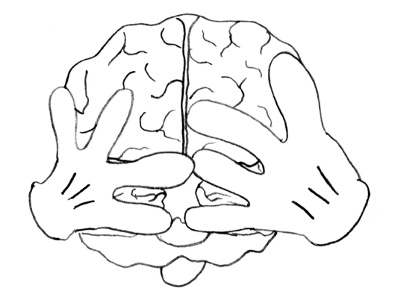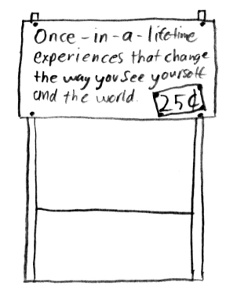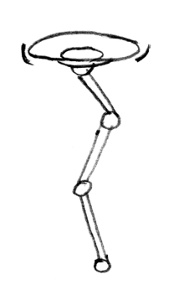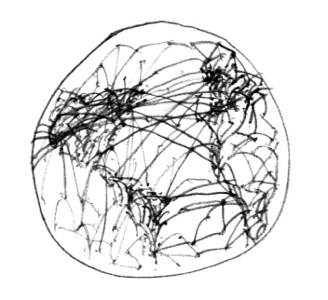
My friend Jeremy recently wrote about the one push-up technique: you don't have to commit to lots of pushups, you can just commit to one. By the time you're all geared up and have done a single pushup, the second one won't seem so difficult and so on. It reminds me of a similar idea I heard once, where you don't commit to run, you just commit to put your shoes on and walk out the door. After that, you can come back in, but chances are you won't.
I think there's something interesting about these kinds of techniques: they rely on a certain lack of analysis. If you know that every time you do one push-up you tend to do more push-ups, or even if you just think about the reason you expect the technique to be useful, it stops being useful. Ugh, I don't feel like doing push-ups today. Well, I only have to do one. But, wait, I know if I do one I'll probably do a few more. Ugh, I don't feel like doing push-ups today.
That's not to say that they can't work, just that for them to work you have to avoid thinking about them. In a sense you are cultivating a deliberate degree of induction blindness: ignoring a pattern that can be derived from repeated experience. Luckily, not thinking is actually fairly easy to do. Really, it's thinking that's the hard thing, but if you're in the habit of thinking about things it can be difficult to turn off, even when it's for your own good.
This idea reminds me a little of the higher power I wrote about earlier. Not thinking seems wildly irrational, and it would be for a purely rational being. However, for irrational beings like us, irrational thinking can lead to rational action. In this case, you're countering one kind of irrationality (avoiding doing something in the moment) with another (tricking yourself into thinking you'll do less than you actually will).
Counterintuitive as it may be, turning off your analytical process and just trusting the system you elected to follow can be a smarter move than trusting your thoughts at a time when they are particularly vulnerable.

Once, when I was younger, I decided to never stay at a party for more than 3 hours. The rationale was that, after that point, you've extracted the optimum value from the party and your time could be better spent elsewhere. I tried it for a little while, but the reality turned out to be pretty unsatisfying. Although I was right that the main experience was usually tapped out at about 3 hours, in many ways that was the least interesting part. The best experiences ended up happening late at night, when whoever was left had run out of party chat and unexpected stuff started happening.
We seem to be awash in a kind of experience economy, with lots of ways to dip your toe into one experience or another. You can extract value from that experience without having to seriously commit to it or make any sacrifices. Voluntourism is an easy target, but only because it so profoundly embodies this spirit of safe and controlled discomfort. Regular tourism itself is also an example, of course, but these days it tends to be rightly recognised as a fun experience more than a challenging one.
The problem with this controlled discomfort is that it comes with a built-in escape hatch. Let's say you've always wanted to live in Japan. So one option is that you stay in Japan for a while and see if you like it. Turns out you don't know the language, you don't have any friends and everything works differently. After a little while you realise that it's too much for you and you leave. Game over. Another option is that you actually move to Japan. Later, it starts to seem too hard and you want to back out. But it's too late; you've moved your whole life over here already. You just have to learn how to make it work.
I wrote before that having control over your situation limits you to the kind of life you can imagine. Similarly, being a tourist limits you to the kind of experiences you don't walk away from. When you start something audacious, like moving to a different country, starting a company, or switching careers, you don't actually know if you can do it. That's what makes it audacious. When you turn out to be insufficient for the task, you have to find a way to become sufficient. Or, if you left an escape hatch, you jump out and it all goes away.
So all of these escape hatch experiences, maybe going to live in Japan for a while, learning a bit of Spanish or something, working on a startup idea and seeing how it goes – I don't think they are worth much. Discomfort that you can turn on and off easily is no real discomfort at all. Like a few hours at a party, you're only ever going to get exactly what you expected. The real experience comes after you commit fully and all the tourists have gone home.

It's much harder to control something that bends in two places than one. For example, balancing on the ground is pretty easy, but balancing on top of a skateboard is much harder. Even worse than that is when the two parts that balance are both trying to compensate for each other. If you're standing on someone's hands, your first instinct is to use your hips to balance, and their instinct is to move under you to balance, resulting in constant over-compensation and eventual pratfall.
In the context of short/long term, I think decisions also have this characteristic. You have one point of articulation in your planning and another in your execution. Making decisions in both places means your short-term and long-term interests both need to compensate for each other. You need to consider when planning that you may change your mind in the moment, and you need to consider in the moment that your plan may be relying on you to change your mind if necessary. Neither point of articulation can trust the other, so you end up second-guessing yourself.
So how do we fix this so we only have one point of articulation? One option would be to design our plans to have no leeway for change in the moment. That would require much more careful planning to account for situations you would otherwise be able to handle on the fly, and still leave you with a high risk of hitting something you didn't plan for. Another option would be not to plan, and just act in the moment. This gives you the benefit of maximum flexibility, but stops you from being able to react to large-scale problems or move consistently towards a big goal.
Both of these solutions are pretty unsatisfying, but maybe we can remove an assumption here: we don't have to operate at the scale of all decisions ever. You could plan some things up front, and leave some for the moment. And, combined with the observation that you can often break a decision down into smaller decisions, that gives a lot more flexibility. Instead of deciding the whole thing at once, you can split it into decide to make up front and decisions to make on the ground.
That sounds a little bit similar to the two-point-articulation situation we started with, but it has a couple of crucial differences. Firstly, the same decision doesn't get touched twice, so you could plan to go for a run sometime tomorrow and then decide to do it in the morning, but not plan to do it in the morning and then decide to do it in the afternoon. Secondly, as a consequence, you need to be very careful not to over-plan. If it doesn't matter whether you run in the morning or afternoon, you may as well leave it unspecified so you can decide at the time what works better.
Like balancing on someone's hands, that involves a certain degree of trust. In making your long-term plans, you need to be able to trust that your short-term actions will stay true to the plan. Conversely, your short-term decisions need to trust that the long-term plan is a good one. Defecting from the plan is a kind of relief valve; if you made a bad plan, you can back out when the badness becomes apparent. To stick to a single point of articulation means giving up that relief valve. So there's a certain degree of pressure in both directions to do the right thing.
That pressure is, in a sense, the real benefit of thinking in this way. You don't want to be second-guessing and compensating for your short-term decisions with your long-term ones or vice versa. Ideally each decision should be made by the most relevant process as best it can. The simpler that decision is, the easier it is, and the more likely to be correct.
The number of points of articulation in a decision is a major contributor to its complexity, so reducing that should lead to better plans, better implementation, and less pratfalls.

Cromulon-7
I'd like to bring this extraordinary symposium to order. Present here are Cromulon-8, Cromulon-5, Cromulon-3, Cromulon-2 and, of, course, Cromulon-7, acting as convenor. Apologies from Cromulon-6; they could not be here due to inclement weather interfering with their transmitters. Cromulon-3, would you care to summarise your findings that led us to call this symposium?
Cromulon-3
Thank you 7, yes. Approximately 30 cromulons ago our progressive scan for extracromular life turned up an intriguing candidate in the Sol system. This was extremely surprising to us as we had previously scanned the system and found nothing of interest. However, we detected an unmistakably life-like electromagnetic pulse coming from Sol-3. For that reason, we immediately called for this extraordinary symposium to discuss it.
Cromulon-2
Wow! You've found life?
Cromulon-3
Well, not so fast. The signal is suggestive but not conclusive. The need for rapid action means we must work with incomplete information. However, what we've found so far is, we must admit, very exciting.
Cromulon-5
Could you describe the pulse please? Why is it life-like?
Cromulon-3
Of course. It has a very distinctive sweeping pattern. The beginning of the pulse is quite weak and in a very narrow range of frequencies, but it immediately began to both broaden and strengthen. Between our noticing the signal and this emergency symposium it has already increased in power by at least ten doublings. The signal itself appears to contain self-similarity at both a large and small scale. It has an extraordinarily low entropy, the lowest of any signal we've investigated so far.
Cromulon-5
So it's not likely to be a false alarm like last time?
Cromulon-3
That's correct.
Cromulon-7
Let's move on, shall we? Thank you for the summary, 3. Cromulon-5, would you care to describe what you have discovered in your analysis of Sol-3's composition and behaviour?
Cromulon-5
Yes. As we're sure you know, 30 cromulons is not very much time to do good analytical work. However, despite this limitation, we have determined a number of interesting things about the composition of Sol-3. It is primarily oceanic, much like 3 is and 4 was.
Cromulon-2
Please...
Cromulon-5
Anyway, it orbits Sol at a period of about 0.3 cromulons, which we are calling 1 sol. It rotates on its axis approximately 365 times per sol. The pulse that 3 mentioned is emanating primarily from two regions concentrated on alternate sides of one of its ocean regions. We believe that these represent its primary transmitting organs, though our understanding is incomplete in this regard as less powerful transmissions are also observed from other sites.
Cromulon-3
Have you found any behavioural explanation for the strongly periodic nature of the transmission?
Cromulon-5
As we said, we are working with limited time. Have you made any progress in decoding it?
Cromulon-3
Not yet, no. Honestly, we're not even entirely sure that what we're dealing with is information at all. It may just be some kind of very complex probe pulse. The only reason we suspect it's anything more is because of this curious periodic structure.
Cromulon-2
What do you mean?
Cromulon-3
Well, the first thing is that the signal has a characteristic power dip every axial rotation. The transmitting organs appear to modulate most strongly in transmission strength and frequency when they are exposed to solar radiation. We believe this may mean their energy source is primarily solar.
Cromulon-5
No, it's not that. We examined Sol-3's composition and it is currently not feasible for that amount of transmission power to be derived from their solar resources. We believe this periodic effect to be behavioural in nature.
Cromulon-3
We thought you didn't have time to analyse its behaviour.
Cromulon-5
We had time to analyse, but you asked if we had an explanation. Those are two different things.
Cromulon-7
5, we appreciate that you have done the best you can with the little time available. Would you care to share with us what you have been able to determine about Sol-3's behaviour?
Cromulon-5
Thank you, yes. By careful analysis of its surface-level electromagnetic and kinetic activity we have determined that there are two primary oscillations. The first of these we are calling the alpha wave. It appears to be approximately but not absolutely synchronised with axial rotation. We believe this to be its primary carrier oscillation, used to modulate other oscillations throughout the body.
Cromulon-3
And you said there was a second primary oscillation?
Cromulon-5
Yes. You may not have detected this, but another oscillation occurs approximately every 7 axial rotations, split into two phases in the ratio 5:2. We are calling this the beta wave. As we notice the two phases differ substantially in kinetic output, and the low-kinetic-output phase coincides with a reduction in intensity of alpha wave activity, we hypothesise this is some form of sleep-wake energy cycle.
Cromulon-2
So it is alive!
Cromulon-5
No. Not exactly. These processes are certainly analogous to behavioural structures we have, but that is not enough for life. We have found many smaller oscillations at different scales, but so far no evidence of coherent oscillations longer than a third of a cromulon in duration. If it is, as 3 said, life-like, it is certainly no more capable of intelligence than Cromulon-1.
Cromulon-2
But 1 could become more intelligent.
Cromulon-5
Or it could end up the same as 4.
Cromulon-2
Please. We don't want to talk about 4.
Cromulon-3
I'm sorry, but it is relevant in this case. Perhaps these small-scale oscillations will stay small as in Cromulon-1, or perhaps they will develop into coherent activity. But there are a lot of kinds of coherence. Are we sure it would be a good thing for Sol-3 to become coherent, even if that comes with the possibility of it becoming unstable and destroying itself?
Cromulon-2
No! We said we don't want to talk about it!
Cromulon-3
There's nothing we could have done.
Cromulon-5
We could have not gotten involved.
Cromulon-7
Okay, let's try to get things back on track here.
Cromulon-2
What if it's lonely?
Cromulon-5
That's not—
Cromulon-8
We will speak now.
Cromulon-7
Go ahead, 8.
Cromulon-8
We are reminded that life may cease without warning. For so few, this is a great loss. So we search for others like us. There may be many things that live, of which our kind is only one. If they are not like us, what will we find? Even we sometimes struggle to comprehend these rapid events. 9 can no longer join us for that reason. Could 1 be likewise unable to communicate with us? If Sol-3 lives, perhaps it lives in its own way. We may learn to understand it, or we may wait until it learns to understand us.



